SUBMARINE
 |
| US Virginia-class submarine underway in Groton , Connecticut , July 2004 |
A submarine (or sub) is a watercraft able to independent operation underwater. It differs from a submersible, which has greater confined underwater functionality. It is also now and again used traditionally or colloquially to consult remotely operated vehicles and robots, in addition to medium-sized or smaller vessels, together with the midget submarine and the moist sub. Submarines are known as "boats" instead of "ships" no matter their length.
 |
| Russian Akula-class submarine of the Nothern Fleet |
Although experimental submarines were constructed before, submarine design took off all through the 19th century, and they have been adopted by using numerous navies. Submarines have been first extensively used during World War I (1914–1918), and at the moment are used in lots of navies, large and small. Military makes use of consist of attacking enemy floor ships (service provider and navy) or other submarines, plane service protection, blockade going for walks, nuclear deterrence, reconnaissance, traditional land assault (as an instance, using a cruise missile), and covert insertion of unique forces. Civilian uses for submarines encompass marine technology, salvage, exploration, and facility inspection and maintenance. Submarines can also be changed to perform extra specialised functions such as search-and-rescue missions or undersea cable restore. Submarines are also used in tourism and undersea archaeology. Modern deep-diving submarines derive from the bathyscaphe, which advanced from the diving bell.
Most huge submarines consist of a cylindrical frame with hemispherical (or conical) ends and a vertical shape, usually located amidships, which houses communications and sensing gadgets as well as periscopes. In modern-day submarines, this shape is the "sail" in American usage and "fin" in European usage. A "conning tower" become a function of earlier designs: a separate strain hull above the primary frame of the boat that allowed the usage of shorter periscopes. There is a propeller (or pump jet) on the rear, and numerous hydrodynamic manipulate fins. Smaller, deep-diving, and distinctiveness submarines may also deviate considerably from this conventional layout. Submarines use diving planes and also change the quantity of water and air in ballast tanks to change buoyancy for submerging and surfacing.
Submarines have one of the widest degrees of sorts and abilties of any vessel. They range from small autonomous examples and one- or two-individual subs that perform for a few hours to vessels which could continue to be submerged for six months—which include the Russian Typhoon class, the biggest submarines ever constructed. Submarines can paintings at more depths than are survivable or practical for human divers.
History
Etymology
The phrase submarine definitely approach 'underwater' or 'underneath-sea' (as in submarine canyon, submarine pipeline) although as a noun it commonly refers to a vessel that can journey underwater. The term is a contraction of submarine boat. And occurs as such in numerous languages, e.G. French (sous-marin), and Spanish (submarino), although others maintain the original time period, inclusive of Dutch (Onderzeeboot), German (Unterseeboot), Swedish (Undervattensbåt), and Russian (подводная лодка: podvodnaya lodka), all of which suggest 'submarine boat'. By naval subculture, submarines are nonetheless generally known as boats in place of as ships, irrespective of their size. Although mentioned informally as boats, U.S. Submarines hire the designation USS (United States Ship) at the beginning in their names, such as USS Alabama. In the Royal Navy, the designation HMS can talk over with "Her Majesty's Ship" or Her Majesty's Submarine", though the latter is every so often rendered "HMS/m" and submarines are normally known as boats instead of ships.
Early human-power submarsibles
16th and 17th centuries
 |
| Drebbel , an early submarsible craft , propelled by oars. |
According to a report in Opusculum Taisnieri posted in 1562:
Two Greeks submerged and surfaced inside the river Tagus near the City of Toledo numerous times in the presence of The Holy Roman Emperor Charles V, with out getting moist and with the flame they carried in their palms still alight.
In 1578, the English mathematician William Bourne recorded in his e-book Inventions or Devises one of the first plans for an underwater navigation vehicle. A few years later the Scottish mathematician and theologian John Napier wrote in his Secret Inventions (1596) that "These inventions besides devises of sayling below water with divers, other devises and strategems for harming of the enemyes by way of the Grace of God and worke of expert Craftsmen I desire to carry out." It's uncertain whether he ever accomplished his concept.
The first submersible of whose construction there exists reliable records changed into designed and constructed in 1620 by means of Cornelis Drebbel, a Dutchman within the carrier of James I of England. It turned into propelled via oars.
18th century
By the mid-18th century, over a dozen patents for submarines/submersible boats have been granted in England. In 1747, Nathaniel Symons patented and built the first known working example of the use of a ballast tank for submersion. His layout used leather baggage that could fill with water to submerge the craft. A mechanism changed into used to curve the water out of the luggage and motive the boat to resurface. In 1749, the Gentlemen's Magazine stated that a similar layout had to begin with been proposed by means of Giovanni Borelli in 1680. Further design development stagnated for over a century, till utility of new technology for propulsion and stability.
The first military submersible become Turtle (1775), a hand-powered acorn-formed tool designed via the American David Bushnell to deal with a single individual. It became the primary proven submarine able to unbiased underwater operation and motion, and the primary to apply screws for propulsion.
19th century
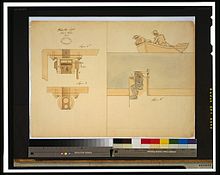 |
1806 illustration by Robert Fulton showing a ( plunging boat ) |
In 1800, France built a human-powered submarine designed by means of American Robert Fulton, Nautilus. The French eventually gave up on the experiment in 1804, as did the British once they later taken into consideration Fulton's submarine layout.
In 1864, late within the American Civil War, the Confederate navy's H. L. Hunley have become the primary navy submarine to sink an enemy vessel, the Union sloop-of-war USS Housatonic. In the aftermath of its successful attack towards the ship, using a gun-powder-filled keg on a spar as a torpedo rate, H. L. Hunley also sank, due to the fact the surprise waves from the explosion killed the team immediately and averted them from pumping the bilge or propelling the submarine.
In 1866, Sub Marine Explorer turned into the primary submarine to efficaciously dive, cruise underwater, and resurface beneath the manage of the team. The layout by German American Julius H. Kroehl (in German, Kröhl) integrated factors which are still used in present day submarines.
In 1866, Flach changed into constructed at the request of the Chilean authorities, via Karl Flach, a German engineer and immigrant. It was the fifth submarine constructed within the world[18] and, in conjunction with a 2nd submarine, became meant to shield the port of Valparaiso towards attack through the Spanish Navy throughout the Chincha Islands War.
Mechanically powered submarines
Submarines couldn't be placed into sizeable or recurring carrier use via navies until suitable engines have been advanced. The generation from 1863 to 1904 marked a pivotal time in submarine development, and several important technology regarded. A quantity of countries built and used submarines. Diesel electric propulsion have become the dominant strength gadget and device such as the periscope have become standardized. Countries performed many experiments on effective strategies and guns for submarines, which caused their big effect in World War I.
1863-1904
 |
| The French submarine Plongeur |
The first submarine not counting on human power for propulsion turned into the French Plongeur (Diver), released in 1863, which used compressed air at 180 psi (1,2 hundred kPa). Narcís Monturiol designed the primary air-independent and combustion-powered submarine, Ictíneo II, which became released in Barcelona, Spain in 1864.
The submarine have become a potentially possible weapon with the development of the Whitehead torpedo, designed in 1866 by way of British engineer Robert Whitehead, the first realistic self-propelled or "locomotive" torpedo. The spar torpedo that were advanced earlier by means of the Confederate States Navy turned into taken into consideration to be impracticable, as it was believed to have sunk each its meant goal, and probable H. L. Hunley, the submarine that deployed it.
The Irish inventor John Philip Holland built a model submarine in 1876 and in 1878 confirmed the Holland I prototype. This changed into followed by way of a number of unsuccessful designs. In 1896, he designed the Holland Type VI submarine, which used internal combustion engine strength on the floor and electric battery power underwater. Launched on 17 May 1897 at Navy Lt. Lewis Nixon's Crescent Shipyard in Elizabeth, New Jersey, Holland VI become purchased by the USA Navy on 11 April 1900, becoming the Navy's first commissioned submarine, christened USS Holland.
Discussions between the English clergyman and inventor George Garrett and the Swedish industrialist Thorsten Nordenfelt led to the primary realistic steam-powered submarines, armed with torpedoes and geared up for army use. The first became Nordenfelt I, a 56-tonne, 19.Five-metre (64 feet) vessel much like Garrett's unwell-fated Resurgam (1879), with a range of 240 kilometres (a hundred thirty nmi; 150 mi), armed with a single torpedo, in 1885.
 |
| Peral at cartagena,1888 |
A reliable method of propulsion for the submerged vessel become handiest made possible within the 1880s with the advent of the important electric battery era. The first electrically powered boats have been built via Isaac Peral y Caballero in Spain (who constructed Peral), Dupuy de Lôme (who constructed Gymnote) and Gustave Zédé (who constructed Sirène) in France, and James Franklin Waddington (who built Porpoise) in England. Peral's design featured torpedoes and different systems that later have become popular in submarines.
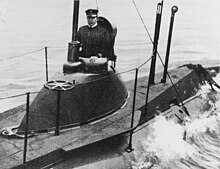 |
| USS Plunger , launched in 1902 |
Commissioned in June 1900, the French steam and electric powered Narval hired the now usual double-hull layout, with a pressure hull within the outer shell. These 2 hundred-ton ships had various over 100 miles (161 km) underwater. The French submarine Aigrette in 1904 in addition improved the concept by means of the usage of a diesel as opposed to a gas engine for surface strength. Large numbers of these submarines have been constructed, with seventy-six finished before 1914.
The Royal Navy commissioned five Holland-class submarines from Vickers, Barrow-in-Furness, beneath licence from the Holland Torpedo Boat Company from 1901 to 1903. Construction of the boats took longer than anticipated, with the primary only ready for a diving trial at sea on 6 April 1902. Although the design were purchased entirely from america organization, the actual design used became an untested development to the unique Holland design using a new a hundred and eighty horsepower (one hundred thirty kW) petrol engine.
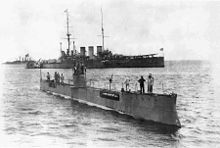 |
| Akula (released in 1907) changed into the primary Russian submarine able to cruise long distances. |
These sorts of submarines had been first used at some stage in the Russo-Japanese War of 1904–05. Due to the blockade at Port Arthur, the Russians despatched their submarines to Vladivostok, wherein through 1 January 1905 there have been seven boats, sufficient to create the world's first "operational submarine fleet". The new submarine fleet commenced patrols on 14 February, generally lasting for about 24 hours each. The first confrontation with Japanese warships came about on 29 April 1905 whilst the Russian submarine Som changed into fired upon with the aid of Japanese torpedo boats, however then withdrew.
World War I
 |
| The German submarine SM U-9, which sank 3 British cruisers in less than an hour in September 1914 |
Military submarines first made a extensive effect in World War I. Forces such as the U-boats of Germany saw action inside the First Battle of the Atlantic, and had been liable for sinking RMS Lusitania, which was sunk because of unrestricted submarine conflict and is often mentioned a few of the motives for the access of the US into the conflict.
At the outbreak of the warfare, Germany had simplest twenty submarines right now available for combat, although these blanketed vessels of the diesel-engined U-19 class, which had a sufficient variety of five,000 miles (eight,000 km) and pace of 8 knots (15 km/h) to allow them to function efficaciously around the entire British coast., By evaluation, the Royal Navy had a total of seventy four submarines, though of combined effectiveness. In August 1914, a flotilla of ten U-boats sailed from their base in Heligoland to assault Royal Navy warships inside the North Sea in the first submarine war patrol in records.
The U-boats' capacity to characteristic as realistic battle machines relied on new approaches, their numbers, and submarine technology inclusive of mixture diesel–electric powered energy gadget developed inside the previous years. More submersibles than true submarines, U-boats operated mainly at the floor using regular engines, submerging sometimes to attack beneath battery strength. They were more or less triangular in cross-phase, with a distinct keel to control rolling even as surfaced, and a wonderful bow. During World War I extra than 5,000 Allied ships have been sunk by using U-boats.
The British answered to the German trends in submarine era with the creation of the K-magnificence submarines. However, these submarines have been notoriously risky to perform because of their diverse layout flaws and terrible maneuverability.
World War II
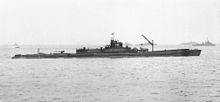 |
| The Imperial Japanese Navy's I-400-magnificence submarine, the largest submarine form of WWII |
During World War II, Germany used submarines to devastating effect within the Battle of the Atlantic, in which it tried to cut Britain's deliver routes via sinking extra merchant ships than Britain should update. These service provider ships have been crucial to supply Britain's population with meals, enterprise with raw material, and military with gasoline and armaments. Although the U-boats were updated inside the interwar years, the important innovation become improved communications, encrypted the use of the Enigma cipher device. This allowed for mass-assault naval procedures (Rudeltaktik, typically referred to as "wolfpack"), but turned into also ultimately the U-boats' downfall. By the cease of the war, nearly three,000 Allied ships (a hundred seventy five warships, 2,825 merchantmen) were sunk via U-boats. Although a hit early in the struggle, Germany's U-boat fleet suffered heavy casualties, dropping 793 U-boats and about 28,000 submariners out of forty one,000, a casualty charge of approximately 70%.
 |
| A version of Günther Prien's U-47, German WWII Type VII diesel–electric powered hunter |
The Imperial Japanese Navy operated the maximum various fleet of submarines of any navy, which includes Kaiten crewed torpedoes, midget submarines (Type A Ko-hyoteki and Kairyu lessons), medium-range submarines, cause-built deliver submarines and lengthy-range fleet submarines. They also had submarines with the best submerged speeds in the course of World War II ( I-201-class submarines) and submarines that might convey multiple aircraft ( I-400-magnificence submarines). They had been additionally prepared with one of the most superior torpedoes of the struggle, the oxygen-propelled Type 95. Nevertheless, in spite of their technical prowess, Japan chose to use its submarines for fleet battle, and therefore have been fantastically unsuccessful, as warships have been rapid, maneuverable and well-defended as compared to service provider ships.
The submarine force changed into the only anti-deliver weapon in the American arsenal. Submarines, even though handiest approximately 2 percent of the U.S. Navy, destroyed over 30 percentage of the Japanese Navy, including eight plane vendors, 1 battleship and eleven cruisers. US submarines additionally destroyed over 60 percentage of the Japanese merchant fleet, crippling Japan's potential to deliver its army forces and commercial struggle attempt. Allied submarines in the Pacific War destroyed greater Japanese delivery than all different weapons combined. This feat changed into drastically aided with the aid of the Imperial Japanese Navy's failure to provide adequate escort forces for the kingdom's merchant fleet.
During World War II, 314 submarines served within the US Navy, of which nearly 260 had been deployed to the Pacific. When the Japanese attacked Hawaii in December 1941, 111 boats had been in fee; 203 submarines from the Gato, Balao, and Tench instructions had been commissioned at some stage in the struggle. During the war, fifty two US submarines were lost to all reasons, with 48 directly due to hostilities. US submarines sank 1,560 enemy vessels, a complete tonnage of 5.3 million tons (55% of the full sunk).
The Royal Navy Submarine Service became used in most cases inside the conventional Axis blockade. Its major running areas had been around Norway, in the Mediterranean (in opposition to the Axis supply routes to North Africa), and within the Far East. In that warfare, British submarines sank 2 million lots of enemy transport and fifty seven predominant warships, the latter including 35 submarines. Among those is the only documented instance of a submarine sinking every other submarine while each have been submerged. This came about when HMS Venturer engaged U-864; the Venturer crew manually computed a a hit firing solution towards a three-dimensionally maneuvering goal the use of techniques which have become the idea of current torpedo laptop concentrated on systems. Seventy-4 British submarines were lost, most of the people, forty-two, inside the Mediterranean.
Cold-War military models
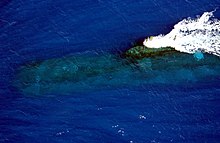 |
| HMAS Rankin, a Collins-elegance submarine at periscope depth |
The first release of a cruise missile (SSM-N-eight Regulus) from a submarine came about in July 1953, from the deck of USS Tunny, a World War II fleet boat changed to hold the missile with a nuclear warhead. Tunny and its sister boat, Barbero, had been the US' first nuclear deterrent patrol submarines. In the Fifties, nuclear power partially replaced diesel–electric powered propulsion. Equipment was additionally advanced to extract oxygen from sea water. These innovations gave submarines the capacity to remain submerged for weeks or months. Most of the naval submarines built in view that that point in the US, the Soviet Union/Russian Federation, Britain, and France have been powered through nuclear reactors.
In 1959–1960, the primary ballistic missile submarines had been put into carrier by way of each america ( George Washington elegance) and the Soviet Union (Golf class) as part of the Cold War nuclear deterrent strategy.
During the Cold War, america and the Soviet Union maintained huge submarine fleets that engaged in cat-and-mouse video games. The Soviet Union lost at the least four submarines for the duration of this era: K-129 turned into lost in 1968 (a part of which the CIA retrieved from the sea floor with the Howard Hughes-designed deliver Glomar Explorer), K-8 in 1970, K-219 in 1986, and Komsomolets in 1989 (which held a depth report amongst navy submarines—1,000 m (three,three hundred ft)). Many different Soviet subs, consisting of K-19 (the primary Soviet nuclear submarine, and the first Soviet sub to attain the North Pole) have been badly broken by way of hearth or radiation leaks. The US misplaced two nuclear submarines during this time: USS Thresher due to equipment failure at some stage in a test dive while at its operational limit, and USS Scorpion because of unknown causes.
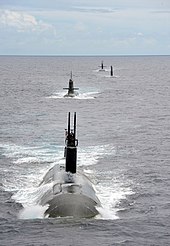 |
| USS Charlotte, a Los Angeles-class submarine runs with submarines from partner international locations at some stage in RIMPAC 2014. |
During India's intervention inside the Bangladesh Liberation War, the Pakistan Navy's Hangor sank the Indian frigate INS Khukri. This changed into the first sinking through a submarine due to the fact World War II. During the same warfare, Ghazi, a Tench-elegance submarine on mortgage to Pakistan from the United States, changed into sunk by means of the Indian Navy. It turned into the primary submarine fight loss because World War II. In 1982 at some stage in the Falklands War, the Argentine cruiser General Belgrano became sunk with the aid of the British submarine HMS Conqueror, the first sinking through a nuclear-powered submarine in conflict. Some weeks later, on 16 June, during the Lebanon War, an unnamed Israeli submarine torpedoed and sank the Lebanese coaster Transit, which changed into wearing 56 Palestinian refugees to Cyprus, inside the notion that the vessel changed into evacuating anti-Israeli militias. The deliver turned into hit through two torpedoes, controlled to ran aground however ultimately sank. There were 25 lifeless, along with her captain. The Israeli Navy disclosed the incident in November 2018.
21th century
Usage
Military
 |
| German UC-1-magnificence World War I submarine. The wires jogging up from the bow to the conning tower are the jumping wires |
Before and at some stage in World War II, the number one position of the submarine turned into anti-floor deliver conflict. Submarines could assault either at the floor using deck guns, or submerged using torpedoes. They were particularly effective in sinking Allied transatlantic transport in each World Wars, and in disrupting Japanese supply routes and naval operations inside the Pacific in World War II.
Mine-laying submarines were evolved in the early a part of the 20th century. The facility was utilized in each World Wars. Submarines were extensively utilized for inserting and putting off covert retailers and military forces in special operations, for intelligence gathering, and to rescue aircrew at some point of air attacks on islands, in which the airmen would be informed of safe locations to crash-land so the submarines ought to rescue them. Submarines may want to convey shipment through adversarial waters or act as supply vessels for other submarines.
 |
| EML Lembit inside the Estonian Maritime Museum. The Lembit is the handiest minelayer submarine of its collection left inside the international.EML Lembit inside the Estonian Maritime Museum. |
Submarines ought to commonly locate and assault other submarines best at the floor, despite the fact that HMS Venturer controlled to sink U-864 with a 4 torpedo unfold while each were submerged. The British evolved a specialised anti-submarine submarine in WWI, the R magnificence. After WWII, with the development of the homing torpedo, higher sonar structures, and nuclear propulsion, submarines additionally became able to hunt every different effectively.
The development of submarine-launched ballistic missile and submarine-released cruise missiles gave submarines a large and lengthy-ranged ability to assault each land and sea objectives with a variety of guns starting from cluster bombs to nuclear weapons.
The number one protection of a submarine lies in its potential to remain hid within the depths of the sea. Early submarines might be detected by means of the sound they made. Water is an first-rate conductor of sound (lots higher than air), and submarines can come across and song comparatively noisy floor ships from lengthy distances. Modern submarines are constructed with an emphasis on stealth. Advanced propeller designs, sizeable sound-lowering insulation, and special equipment help a submarine stay as quiet as ambient ocean noise, making them difficult to hit upon. It takes specialised generation to locate and assault cutting-edge submarines.
Active sonar uses the mirrored image of sound emitted from the search equipment to detect submarines. It has been used on account that WWII by using floor ships, submarines and plane (through dropped buoys and helicopter "dipping" arrays), but it famous the emitter's role, and is vulnerable to counter-measures.
A concealed army submarine is a actual risk, and due to its stealth, can force an enemy military to waste sources searching massive areas of ocean and protecting ships in opposition to attack. This gain turned into vividly established inside the 1982 Falklands War while the British nuclear-powered submarine HMS Conqueror sank the Argentine cruiser General Belgrano. After the sinking the Argentine Navy diagnosed that they had no powerful protection in opposition to submarine attack, and the Argentine surface fleet withdrew to port for the remainder of the warfare, though an Argentine submarine remained at sea.
Civilian
Although the general public of the arena's submarines are military, there are a few civilian submarines, which can be used for tourism, exploration, oil and gasoline platform inspections, and pipeline surveys. Some are also used in unlawful sports.
The Submarine Voyage ride opened at Disneyland in 1959, however even though it ran underneath water it became no longer a real submarine, because it ran on tracks and turned into open to the surroundings. The first traveler submarine changed into Auguste Piccard, which went into provider in 1964 at Expo64. By 1997 there were 45 tourist submarines running around the arena.[50] Submarines with a overwhelm intensity inside the range of 400–500 toes (120–one hundred fifty m) are operated in numerous areas international, typically with backside depths round one hundred to one hundred twenty toes (30 to 37 m), with a wearing capacity of fifty to a hundred passengers.
In a typical operation a floor vessel incorporates passengers to an offshore running vicinity and loads them into the submarine. The submarine then visits underwater points of hobby such as natural or artificial reef structures. To surface effectively without hazard of collision the region of the submarine is marked with an air launch and movement to the surface is coordinated by way of an observer in a assist craft.
A recent improvement is the deployment of so-called narco-submarines by South American drug smugglers to stay away from law enforcement detection. Although they sometimes installation authentic submarines, most are self-propelled semi-submersibles, in which a part of the craft remains above water always. In September 2011, Colombian government seized a 16-meter-long submersible that could preserve a group of 5, costing about $2 million. The vessel belonged to FARC rebels and had the capability to carry at least 7 tonnes of medicine.
Civilian submarines
 |
| Model of the Mesoscaphe Auguste Piccard |
Technology
Buoyancy and trim
 |
| An illustration showig submarine control surface and trim tanks |
All surface ships, as well as surfaced submarines, are in a positively buoyant condition, weighing less than the extent of water they could displace if absolutely submerged. To submerge hydrostatically, a ship ought to have poor buoyancy, both through growing its own weight or lowering its displacement of water. To control their displacement and weight, submarines have ballast tanks, which could maintain various quantities of water and air.
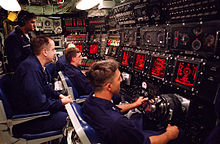 |
| USS Seawolf (SSN-21) Ship Control Panel, with yokes for manipulate surfaces (planes and rudder), and Ballast Control Panel (history), to govern the water in tanks and deliver's trim |
For widespread submersion or surfacing, submarines use the primary ballast tanks (MBTs), which might be ambient stress tanks, filled with water to submerge, or with air to surface. While submerged, MBTs typically stay flooded, which simplifies their design, and on many submarines these tanks are a segment of the distance among the mild hull and the strain hull. For extra unique control of intensity, submarines use smaller depth control tanks (DCTs)—additionally known as tough tanks (because of their ability to face up to higher stress), or trim tanks. These are variable buoyancy strain vessels, a type of buoyancy manage tool. The quantity of water intensive control tanks can be adjusted to hydrostatically trade intensity or to preserve a regular intensity as out of doors conditions (specifically water density) change. Depth manipulate tanks may be positioned either near the submarine's center of gravity, to minimise the effect on trim, or separated alongside the period of the hull so that they can also be used to alter static trim with the aid of transfer of water among them.
When submerged, the water pressure on a submarine's hull can reach four MPa (580 psi) for metallic submarines and up to 10 MPa (1,500 psi) for titanium submarines like K-278 Komsomolets, at the same time as interior pressure stays exceptionally unchanged. This difference effects in hull compression, which decreases displacement. Water density also marginally increases with intensity, because the salinity and strain are higher. This trade in density incompletely compensates for hull compression, so buoyancy decreases as depth increases. A submerged submarine is in an volatile equilibrium, having an inclination to either sink or waft to the floor. Keeping a consistent depth calls for chronic operation of both the depth manage tanks or control surfaces.
Submarines in a neutral buoyancy condition aren't intrinsically trim-strong. To preserve preferred longitudinal trim, submarines use forward and aft trim tanks. Pumps pass water among the tanks, changing weight distribution and pitching the sub up or down. A comparable device may be used to maintain transverse trim.
Control surface
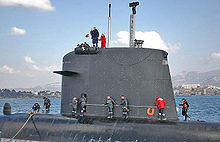 |
| Sail of the French nuclear submarine Casabianca; note the diving planes, camouflaged masts, periscope, electronic struggle masts, hatch, and deadlight. |
The hydrostatic effect of variable ballast tanks isn't always the only manner to control the submarine underwater. Hydrodynamic maneuvering is finished through several manipulate surfaces, collectively known as diving planes or hydroplanes, which can be moved to create hydrodynamic forces whilst a submarine moves longitudinally at enough velocity. In the conventional cruciform stern configuration, the horizontal stern planes serve the identical motive because the trim tanks, controlling the trim. Most submarines moreover have ahead horizontal planes, usually positioned on the bow until the Nineteen Sixties but often at the sail on later designs, where they are toward the center of gravity and might manipulate depth with less effect at the trim.
 |
| Rear view of a version of Swedish submarine HMS Sjöormen, the primary manufacturing submarine to feature an x-stern |
An apparent manner to configure the control surfaces on the stern of a submarine is to apply vertical planes to manipulate yaw and horizontal planes to govern pitch, which gives them the shape of a move while seen from astern of the vessel. In this configuration, which lengthy remained the dominant one, the horizontal planes are used to manipulate the trim and intensity and the vertical planes to control sideways maneuvers, like the rudder of a floor ship.
Alternatively, the rear manage surfaces may be blended into what has grow to be referred to as an x-stern or an x-rudder. Although much less intuitive, such a configuration has became out to have numerous advantages over the traditional cruciform association. First, it improves maneuverability, horizontally in addition to vertically. Second, the manipulate surfaces are less likely to get damaged whilst landing on, or departing from, the seabed as well as whilst mooring and unmooring along. Finally, it is safer in that one of the diagonal strains can counteract the opposite with admire to vertical in addition to horizontal movement if considered one of them by chance receives caught.
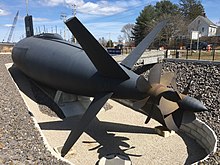 |
| USS Albacore, the first submarine to use an x-rudder in exercise, now on display in Portsmouth, New Hampshire |
The x-stern became first tried in exercise in the early Nineteen Sixties on the USS Albacore, an experimental submarine of the US Navy. While the association became found to be tremendous, it became nevertheless no longer used on US production submarines that accompanied because of the reality that it requires using a computer to manipulate the manipulate surfaces to the favored impact. Instead, the primary to apply an x-stern in fashionable operations became the Swedish Navy with its Sjöormen magnificence, the lead submarine of which become released in 1967, before the Albacore had even completed her check runs. Since it became out to work thoroughly in exercise, all next classes of Swedish submarines (Näcken, Västergötland, Gotland, and Blekinge magnificence) have or will come with an x-rudder.
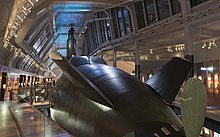 |
| The x-rudder of HMS Neptun, a Näcken-magnificence submarine in service with the Swedish Navy 1980–1998, now on display at Marinmuseum in Karlskrona |
The Kockums shipyard chargeable for the layout of the x-stern on Swedish submarines subsequently exported it to Australia with the Collins magnificence as well as to Japan with the Sōryū class. With the introduction of the sort 212, the German and Italian Navies got here to function it as properly. The US Navy with its Columbia magnificence, the British Navy with its Dreadnought class, and the French Navy with its Barracuda class are all about to join the x-stern circle of relatives. Hence, as judged by using the state of affairs inside the early 2020s, the x-stern is about to come to be the dominant technology.
When a submarine plays an emergency surfacing, all depth and trim control strategies are used concurrently,[citation needed] collectively with propelling the boat upwards. Such surfacing may be very brief, so the sub may additionally even in part bounce out of the water, probably detrimental submarine systems.
Hull
Overview
 |
| The US Navy Los Angeles-class USS Greeneville in dry dock, displaying cigar-shaped hull |
Modern submarines are cigar-fashioned. This design, also used in very early submarines, is sometimes called a "teardrop hull". It reduces hydrodynamic drag when the sub is submerged, however decreases the ocean-preserving abilties and will increase drag whilst surfaced. Since the constraints of the propulsion structures of early submarines forced them to perform surfaced most of the time, their hull designs have been a compromise. Because of the slow submerged speeds of those subs, typically, properly below 10 kt (18 km/h), the accelerated drag for underwater travel changed into acceptable. Late in World War II, whilst technology allowed faster and longer submerged operation and elevated plane surveillance forced submarines to stay submerged, hull designs have become teardrop fashioned again to lessen drag and noise. USS Albacore (AGSS-569) changed into a unique research submarine that pioneered the American model of the teardrop hull shape (from time to time called an "Albacore hull") of contemporary submarines. On modern-day military submarines the outer hull is covered with a layer of sound-absorbing rubber, or anechoic plating, to lessen detection.
The occupied strain hulls of deep-diving submarines together with DSV Alvin are round rather than cylindrical. This lets in a extra even distribution of strain and green use of materials to face up to outside stress because it gives the most inner extent for structural weight and is the most efficient form to avoid buckling instability in compression. A body is typically affixed to the out of doors of the strain hull, supplying attachment for ballast and trim systems, scientific instrumentation, battery packs, syntactic flotation foam, and lighting.
A raised tower on pinnacle of a preferred submarine contains the periscope and electronics masts, that can include radio, radar, electronic warfare, and different structures. It may encompass a snorkel mast. In many early training of submarines (see records), the manage room, or "conn", changed into located interior this tower, which was known as the "conning tower". Since then, the conn has been placed within the hull of the submarine, and the tower is now referred to as the "sail" or "fin". The conn is distinct from the "bridge", a small open platform within the pinnacle of the sail, used for remark during surface operation.
"Bathtubs" are related to conning towers but are used on smaller submarines. The bath is a steel cylinder surrounding the hatch that prevents waves from breaking directly into the cabin. It is needed due to the fact surfaced submarines have confined freeboard, that is, they lie low in the water. Bathtubs help save you swamping the vessel.
Signle and double hulls
 |
| U-995, Type VIIC/forty one U-boat of World War II, showing the deliver-like traces of the outer hull for floor tour, mixed into the cylindrical strain hull structure. |
Modern submarines and submersibles normally have, as did the earliest fashions, a single hull. Large submarines usually have a further hull or hull sections out of doors. This outside hull, which without a doubt bureaucracy the shape of submarine, is known as the outer hull (casing in the Royal Navy) or light hull, as it does now not ought to withstand a strain distinction. Inside the outer hull there may be a sturdy hull, or stress hull, which withstands sea stress and has normal atmospheric stress inside.
As early as World War I, it was found out that the ideal shape for withstanding strain conflicted with the top-quality form for seakeeping and minimum drag at the floor, and construction problems in addition complex the trouble. This changed into solved both through a compromise shape, or through using layered hulls: the internal electricity hull for withstanding strain, and an outside fairing for hydrodynamic shape. Until the quit of World War II, maximum submarines had a further partial casing on the top, bow and stern, built of thinner metallic, which become flooded whilst submerged. Germany went further with the Type XXI, a popular predecessor of present day submarines, wherein the stress hull became absolutely enclosed within the light hull, however optimized for submerged navigation, not like earlier designs that have been optimized for floor operation.
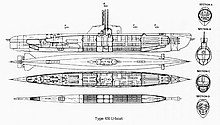 |
| Type XXI U-boat, overdue World War II, with pressure hull almost fully enclosed within the light hull |
After World War II, techniques cut up. The Soviet Union changed its designs, basing them on German developments. All submit-World War II heavy Soviet and Russian submarines are built with a double hull structure. American and most other Western submarines switched to a by and large unmarried-hull approach. They nevertheless have light hull sections within the bow and stern, which residence major ballast tanks and provide a hydrodynamically optimized shape, but the foremost cylindrical hull phase has most effective a unmarried plating layer. Double hulls are being taken into consideration for destiny submarines inside the United States to enhance payload capacity, stealth and variety.
WRITTEN BY : ADRISH WAHEED
Labels: SUBMARINE
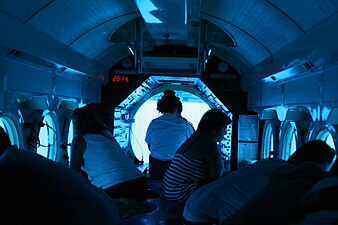
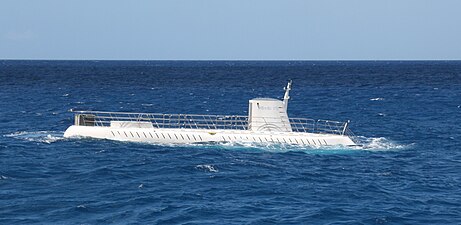

0 Comments:
Post a Comment
Subscribe to Post Comments [Atom]
<< Home